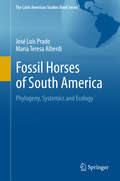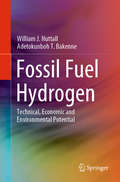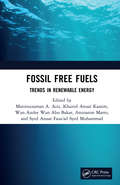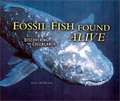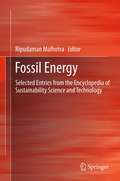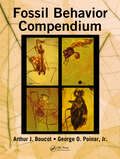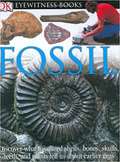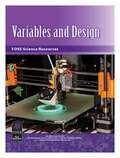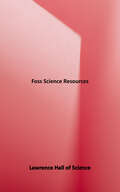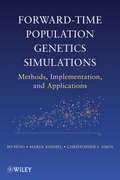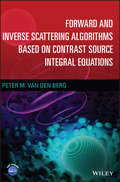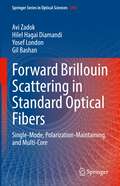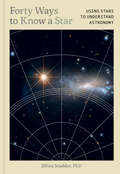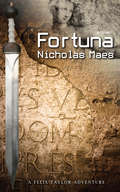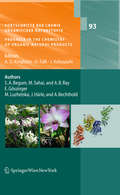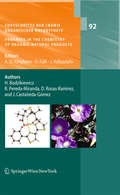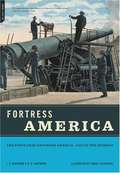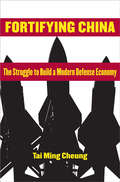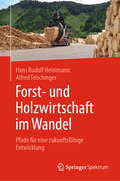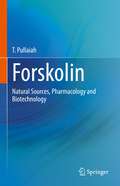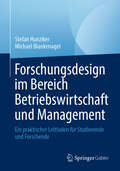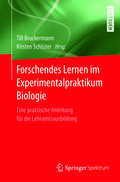- Table View
- List View
Fossil Horses of South America
by José Luis Prado María Teresa AlberdiThis book provides an update on the phylogeny, systematics and ecology of horses in South America based on data provided over the past three decades. The contemporary South American mammalian communities were shaped by the emergence of the Isthmus of Panama and by the profound climatic oscillations during the Pleistocene. Horses were a conspicuous group of immigrant mammals from North America that arrived in South America during the Pleistocene. This group is represented by 2 genera, Hippidion and Equus, which include small species (Hippidion devillei, H. saldiasi, E. andium and E. insulatus) and large forms (Equus neogeus and H. principale). Both groups arrived in South America via 2 different routes. One model designed to explain this migration indicates that the small forms used the Andes corridor, while larger horses used the eastern route and arrived through some coastal areas. Molecular dating (ancient DNA) suggests that the South American horses separated from the North American taxa (caballines and the New World stilt-legged horse) after 3.6 - 3.2 Ma, consistent with the final formation of the Panamanian Isthmus. Recent studies of stable isotopes in these horses indicate an extensive range of 13C values cover closed woodlands to C4 grasslands. This plasticity agrees with the hypothesis that generalist species and open biome specialist species from North America indicate a positive migration through South America.
Fossil Fuel Hydrogen: Technical, Economic and Environmental Potential
by William J. Nuttall Adetokunboh T. BakenneAs the case for Climate Change mitigation becomes ever more pressing, hydrogen has the potential to play a major role in a low-carbon energy future. Hydrogen can drive the vehicles of tomorrow and also heat homes and supply energy to businesses. Much recent discussion in energy policy circles has considered ways in which greatly expanded electrification can meet the demand for low-carbon mobility and heating. Such narratives centre on the widespread use of renewable energy sources with occasionally surplus renewable electricity being used to produce hydrogen, for example by electrolysis. While such developments have a beneficial role to play, this book focuses on an alternative paradigm. This book considers a more evolutionary path involving the continued extraction and use of fossil fuels, most notably natural gas, but in ways that greatly reduce greenhouse gas emissions. In this way much established industrial capacity and know how might be transitioned to help deliver the low carbon future that the world so desperately requires. Presenting up-to-date energy policy recommendations with a focus on hydrogen from fossil fuels, the book will be of considerable interest to policymakers and energy researchers in academia, industry and government labs, while also offering a valuable reference guide for business developers in low-carbon energy, and for oil and gas industry analysts.
Fossil Fuel (Energy Essentials)
by Nigel Saunders Steven ChapmanThis book tells you all about fossil fuel--coal, oil, and natural gas. It tells you amazing facts about how they were made and how we can use them in our everyday lives. It also explains the problems that fossil fuel can cause and how we need to find other ways of fueling our world--and soon.
Fossil Free Fuels: Trends in Renewable Energy
by Maniruzzaman AzizMany approaches have been undertaken to mitigate global climate change, including the movement away from fossil fuels. Fossil Free Fuels: Trends in Renewable Energy examines several key topics, such as the utilization of biofuels as a sustainable renewable resource, recycling and untapped waste-to-energy products, and other carbon-neutral strategies in various industries, such as the transportation, construction, and manufacturing sectors. It provides recent updates on the latest technologies, modeling, design, and technical aspects, as well as several practical case studies. The current world energy scenario is examined and various solutions to larger environmental problems are outlined in terms of the shift to more alternative energy sources. Features: Minimizes technical jargon in a straightforward style for a wider audience Discusses sustainable options for different industries, such as the use of green materials in the construction sector, biofuels for transportation, and many more Includes numerous illustrations, tables, and figures to aid in understanding This book serves as a practical reference for engineers, researchers, environmental consultants working in renewable energy industries, and students.
Fossil Fish Found Alive: Discovering the Coelacanth
by Sally M. WalkerDescribes the 1938 discovery of the coelacanth, a fish previously believed to be extinct, and subsequent research about it.
Fossil Energy
by Ripudaman MalhotraThe word sustainability shares its root with sustenance. In the context of modern society, sustenance is inextricably linked to the use of energy. Fossil Energy provides an authoritative reference on all aspects of this key resource, which currently represents nearly 85% of global energy consumption. Gathering 16 peer-reviewed entries from the Encyclopedia of Sustainability Science and Technology, the chapters provide comprehensive, yet concise coverage of fundamentals and current areas of research. Written by recognized authorities in the field, this volume represents an essential resource for scientists and engineers working on the development of energy resources, fossil or alternative, and reflects the essential role of energy supplies in supporting a sustainable future.
Fossil Behavior Compendium
by Arthur J. Boucot George O. Poinar Jr.In this complete and thorough update of Arthur Boucot's seminal work, Evolutionary Paleobiology of Behavior and Coevolution, Boucot is joined by George Poinar, who provides additional expertise and knowledge on protozoans and bacteria as applied to disease. Together, they make the Fossil Behavior Compendium wider in scope, covering all relevant ani
Fossil (DK Eyewitness Books)
by Paul D. TaylorA photo essay about different types of fossils, including bacteria, algae, birds, mammals and more.
Foss Weather and Water Lab Notebook
by Lawrence Hall of ScienceA lab notebook to accompany the student text.
Foss Science: Variables and Design
by Lawrence Hall of Science University of California at BerkeleyFOSS Next Generation Variables and Design Science Resources Student Book
Foss Science Resources
by Lawrence Hall of ScienceFOSS Science Resources is a book of original readings developed to accompany each FOSS module. The readings are referred to as articles in the Investigations Guide Students will read the articles in the book as they progress through the module; these articles cover a specific concept usually after that concept has been introduced in an active investigation. Together, the articles in FOSS Science Resources and the discussion questions provided in the Investigation Guide help students make connections to the science concepts introduced and explored during the active investigations. Features - FOSS Science Resources are developed specifically to complement FOSS modules of the same titles and help lead to a deeper understanding of a key life, earth, or physical science concept - Concept development is most effective when students are allowed to experience organisms, objects, and phenomena first-hand before engaging the concepts in text - Colorful photographs, key standards-based science content, and developmentally-appropriate interactive text help enhance the overall science learning experience - Book includes a science and literacy blackline activity master and directions for a hands-on activity - Educators are also provided with easy-to-use science and literacy teaching support and strategies for meeting individual learning needs
Forward-Time Population Genetics Simulations
by Bo Peng Marek Kimmel Christopher I. AmosThe only book available in the area of forward-time population genetics simulations--applicable to both biomedical and evolutionary studies The rapid increase of the power of personal computers has led to the use of serious forward-time simulation programs in genetic studies. Forward-Time Population Genetics Simulations presents both new and commonly used methods, and introduces simuPOP, a powerful and flexible new program that can be used to simulate arbitrary evolutionary processes with unique features like customized chromosome types, arbitrary nonrandom mating schemes, virtual subpopulations, information fields, and Python operators. The book begins with an overview of important concepts and models, then goes on to show how simuPOP can simulate a number of standard population genetics models--with the goal of demonstrating the impact of genetic factors such as mutation, selection, and recombination on standard Wright-Fisher models. The rest of the book is devoted to applications of forward-time simulations in various research topics. Forward-Time Population Genetics Simulations includes: An overview of currently available forward-time simulation methods, their advantages, and shortcomings An overview and evaluation of currently available software A simuPOP tutorial Applications in population genetics Applications in genetic epidemiology, statistical genetics, and mapping complex human diseases The only book of its kind in the field today, Forward-Time Population Genetics Simulations will appeal to researchers and students of population and statistical genetics.
Forward and Inverse Scattering Algorithms Based on Contrast Source Integral Equations
by Peter M. van den BergA guide to wave-field computational methods based on contrast source type of integral equations Forward and Inverse Scattering Algorithms Based on Contrast Source Integral Equations presents a text that examines wave-field computational methods based on contrast source type of integral equations and the computational implementation in wave-field based imaging methods. Written by a noted expert on the topic, the book provides a guide to efficient methods for calculating wave fields in a known inhomogeneous medium. The author provides a link between the fundamental scattering theory and its discrete counterpart and discusses the forward scattering problem based on the contrast-source integral equations. The book fully describes the calculation of wave fields inside and outside a scattering object with general shape and material property and reviews the inverse scattering problem, in which material properties are resolved from wave-field measurements outside the scattering object. The theoretical approach is the inverse of the forward scattering problem that determines how radiation is scattered, based on the scattering object. This important book: Provides a guide to the effects of scalar waves, acoustic waves and electromagnetic waves Describes computer modeling in 1D, 2D and 3D models Includes an online site for computer codes with adjustable configurations Written for students, researchers, and professionals, Forward and Inverse Scattering Algorithms Based on Contrast Source Integral Equations offers a guide to wave-field computational methods based on contrast source type of integral equations and the computational implementation in wave-field based imaging methods.
Forward Brillouin Scattering in Standard Optical Fibers: Single-Mode, Polarization-Maintaining, and Multi-Core (Springer Series in Optical Sciences #240)
by Avi Zadok Hilel Hagai Diamandi Yosef London Gil BashanThis book, the first dedicated to the topic, provides a comprehensive treatment of forward stimulated Brillouin scattering (SBS) in standard optical fibers. SBS interactions between guided light and sound waves have drawn much attention for over fifty years, and optical fibers provide an excellent playground for the study of Brillouin scattering as they support guided modes of both wave types and provide long interaction lengths. This book is dedicated to forward SBS processes that are driven by co-propagating optical fields. The physics of forward SBS is explained in detail, starting from the fundamentals of interactions between guided optical and acoustic waves, with emphasis given to the acoustic modes that are stimulated in the processes. The realization of forward SBS in standard single-mode, polarization-maintaining and multi-core fibers is then discussed in depth. Innovative potential applications in sensors, monitoring of coating layers, lasers, and radio-frequency oscillators are presented. This book introduces the subject to graduate students in optics and applied physics, and it will be of interest to scientists working in fiber-optics, nonlinear optics and opto-mechanics.Provides the first treatment of forward stimulated Brillouin scattering (SBS) in book form;Reflects the dramatic recent increase in interest in forward SBS processes , driven in part by the promise of new fiber sensing concepts;Delivers a solid and comprehensive grounding in the physics of forward SBS along with detailed experimental set-ups, measurement protocols, and applications.
Forty Ways to Know a Star: Using Stars to Understand Astronomy
by Jillian ScudderExplore the fascinating facts and visual wonder of stars in this easy-to-read and beautifully illustrated guide from astrophysicist and popular science blogger Dr. Jillian Scudder.Stars, the building blocks of the universe, are simply luminous spheres of plasma held together by gravity, but there are many kinds and many remarkable examples. Astoundingly, there are at least 100 billion stars in our galaxy and an estimated two trillion galaxies in our visible universe. Understanding the birth, life, and death of stars is key to a knowledge of astronomy.40 Ways to Know a Star offers forty short essays that explore everything from the Milky Way to planetary nebulae, from how a star is born to the colors of stars, each enhanced by a color illustration or graphic image. Dr. Scudder, whose popular Astroquizzical blog features an engaging "ask an astronomer" format, writes in a way that makes complex physics accessible. Magnificent imagery of the heavens, including ten color plates featuring NASA photographs, makes this space book as enticing as it is informative.ASTROPHYSICS EXPERT: Dr. Jillian Scudder is an astrophysicist and Associate Professor of Physics at Oberlin College, Ohio. She hosts and writes Astroquizzical, a blog in which she tackles some of the mysteries of the universe by answering space-related questions from the public.ACCESSIBLE CONTENT: This unique science book helps any reader understand our universe; it is full of charts and distinctive color illustrations that give clear and accessible explanations of the content and a resource page for further exploration.ASTRONOMY GIFT: Beautifully designed inside and out, the book’s cover features gold foil to highlight the stellar content, making it an excellent coffee table book or gift for astronomy enthusiasts of all levels.Perfect for:Astronomy and space enthusiastsTeachers, librarians, and students seeking an instructive and accessible resourceGift-giving for graduation, birthday, retirement, Mother's Day, Father's Day, or any occasion for people interested in science and technologyFans of popular science books by Neil deGrasse Tyson, Bill Nye, NASA, and National Geographic
Fortuna: A Felix Taylor Adventure
by Nicholas MaesFelix Taylor once stopped a devastating plague, but now he must save his world from humankind itself. It’s been a year since Felix Taylor travelled back to ancient Rome and saved his world from a lethal plague. Again his knowledge of Latin seems useless now that life in the 23rd century has returned to normal. But is it really?A stranger has discovered the time machine and used it to project back into the past. It becomes clear his purpose is to reverse Felix’s success, to bring back the plague and doom future generations to death. To make matters worse, this stranger is very close to Felix.With help from his friend Carolyn, Felix must return to the world of Julius Caesar, as well as a later era divided by religion, to stop the re-emergence of the plague. If he fails to do so, his world will turn to dust like ancient Rome.
Fortschritte der Chemie organischer Naturstoffe / Progress in the Chemistry of Organic Natural Products, Vol. 93
by A. Douglas Kinghorn Heinz Falk Junichi Kobayashi Sajeli A. Begum Johannes Härle Marta Luzhetska Anil B. Ray Edda Gössinger Mahendra SahaiThe volumes of this classic series, now referred to simply as "Zechmeister" after its founder, L. Zechmeister, have appeared under the Springer Imprint ever since the series' inauguration in 1938. The volumes contain contributions on various topics related to the origin, distribution, chemistry, synthesis, biochemistry, function or use of various classes of naturally occurring substances ranging from small molecules to biopolymers. Each contribution is written by a recognized authority in his field and provides a comprehensive and up-to-date review of the topic in question. Addressed to biologists, technologists, and chemists alike, the series can be used by the expert as a source of information and literature citations and by the non-expert as a means of orientation in a rapidly developing discipline.
Fortschritte der Chemie organischer Naturstoffe / Progress in the Chemistry of Organic Natural Products, Vol. 92
by A. Douglas Kinghorn Herbert Budzikiewicz Heinz Falk Rogelio Pereda-Miranda Daniel Rosas-Ramírez Junichi Kobayashi Jhon Castañeda-GómezThe volumes of this classic series, now referred to simply as "Zechmeister" after its founder, L. Zechmeister, have appeared under the Springer Imprint ever since the series' inauguration in 1938. The volumes contain contributions on various topics related to the origin, distribution, chemistry, synthesis, biochemistry, function or use of various classes of naturally occurring substances ranging from small molecules to biopolymers. Each contribution is written by a recognized authority in his field and provides a comprehensive and up-to-date review of the topic in question. Addressed to biologists, technologists, and chemists alike, the series can be used by the expert as a source of information and literature citations and by the non-expert as a means of orientation in a rapidly developing discipline.
Fortress America: The Forts That Defended America, 1600 To The Present
by J. E. KaufmannFrom the earliest colonial settlements to Cold War bunkers, the North American continent has been home to thousands of forts and fortress structures. Fortress America surveys the broad sweep of fortifications throughout North America-from seacoast forts of the late eighteenth century to wooden inland forts built to defend against Native American, English,French, or Spanish attack; from Civil War-era coastal and inland waterways forts to the Great Plains' forts of the Old West; from World War II subterranean bunkers to Cold Warconcrete missile silos. The text of Fortress America is complemented with never-before-published photographs, and extraordinary drawings, cut-aways, and diagrams illustrating the design and structure of American forts.
Fortifying China: The Struggle to Build a Modern Defense Economy
by Tai Ming CheungFortifying China explores the titanic struggle to turn China into an aspiring world-class military technological power. The defense economy is leveraging the country's vibrant civilian economy and gaining access to foreign sources of technology and know-how. Drawing on extensive Chinese-language sources, Tai Ming Cheung explains that this transformation has two key dimensions. The defense economy is being reengineered to break down bureaucratic barriers and reduce the role of the state, fostering a more competitive and entrepreneurial culture to facilitate the rapid diffusion and absorption of technology and knowledge. At the same time, the civilian and defense economies are being integrated to form a dual-use technological and industrial base.In Cheung's view, the Chinese authorities believe this strategy will play a key role in supporting long-term defense modernization. For China's neighbors and the United States, understanding China's technological, industrial, and military capabilities is critical to the formulation of economic and security policies. Fortifying China provides crucial insight into the impact of China's dual-use technology strategy. Cheung's "systems of innovation" framework considers the structure, dynamics, and performance of the defense economy from a systems-level perspective.
Forst- und Holzwirtschaft im Wandel: Pfade für eine zukunftsfähige Entwicklung
by Hans Rudolf Heinimann Alfred TeischingerDas vorliegende Buch bietet eine Auslegeordnung, wie sich die Forst- und Holzwirtschaft Mitteleuropas orientieren kann, um die Nachhaltigkeits- und Klimawende mitzugestalten und zu einer Bioökonomie und Kreislaufwirtschaft beizutragen. Die Leitidee des Buches ist es, Optionen darzustellen und dies in der Absicht, die Vielfalt des Denkens und Handelns zu inspirieren. Vielfalt ist eine Voraussetzung, um mit unsicheren und unerwarteten Ereignissen, mit denen wir vermehrt konfrontiert sein werden, umgehen zu können. Das Buch analysiert, was die Leitbilder und Konzepte, welche den Nachhaltigkeits-, den Klima- sowie den sozialen Wandel prägen, für den Forst- und Holzsektor bedeuten. Es stellt danach die Hindernisse, welche die angestrebten Wenden behindern, und die „objektiven Realitäten“ dar, von denen eine Anpassung des Forst- und Holzsektors ausgehen muss. Die Pfade einer zukunftsfähigen Entwicklung beschreiben das wald- und holzspezifische Management des Kohlenstoffkreislaufes, die Weiterentwicklung des sozialen, institutionellen Arrangements, die Weiterentwicklung der Waldbausysteme sowie die Zukunft der stofflichen und energetischen Nutzung von Holz. Das Spektrum bisheriger Beiträge zum aktuellen Wandel sowie zu den Erwartungen und Anforderungen an Lösungen ist sehr breit und verkörpert die jeweils sehr spezifische Sichtweise einzelner Interessensgruppen. Dieses Buch ist ein Beitrag, Licht in das objektive Ödland, das in den letzten Jahren entstanden ist, zu werfen, und neben der Biodiversität in Wald und Natur auch die Diversität der Ideen zur erfolgreichen Bewältigung des Wandels zu stimulieren.
Forskolin: Natural Sources, Pharmacology and Biotechnology
by T. PullaiahThis monograph compiles updated information about forskolin, a labdane diterpene that is produced by the Coleus plant. Forskolin has a large number of practical uses and the book delves into the various aspects of this chemical. It includes topics such as the botanical source of forskolin and the cultivation of Coleus forskohlii, source. It also covers the biosynthetic pathways in natural sources and also through different biotechnological applications. Chapters include the potential and products in the Forskolin market. The book also covers the methods for enhanced production of forskolin from natural sources and through tissue culture methods for improvement of the plant for higher content of forskolin. It discusses the role of endophytes in the production of forskolin.The book is useful for students and researchers in the field of botany, pharmacology and biochemistry. It also serves scientists in various pharmaceutical industries.
Forschungsdesign im Bereich Betriebswirtschaft und Management: Ein praktischer Leitfaden für Studierende und Forschende
by Stefan Hunziker Michael BlankenagelDieses Lehrbuch über Forschungsdesigns bietet Bachelor- und Masterstudierenden eine detaillierte Anleitung zur Bewältigung ihrer Forschungsprojekte. Es wurde für universitäre Kurse in Deutschland, Österreich und der Schweiz empfohlen und entwickelt. Die Autoren bieten den Studierenden relevante Forschungsdesigns im Bereich Betriebswirtschaft und Management an. Sie zeigen, wie man die übliche Trennung zwischen qualitativen und quantitativen Methoden überwinden kann. Zu diesem Zweck konzentriert sich das Lehrbuch auf den wissenschaftlichen Problemlösungsprozess und betont die Bedeutung eines angemessenen Forschungsdesigns für die Erzielung intellektueller Beiträge. Die Autoren beschreiben die relevantesten Forschungsdesigns im Bereich Betriebswirtschaft und Management und bewerten jedes Forschungsdesign hinsichtlich seiner Eignung zur Beantwortung spezifischer Forschungsfragen. Das Lehrbuch behandelt auch das wissenschaftliche Schreiben und bietet wertvolle Tipps zumgesamten Forschungsprozess. Es dient den Studierenden nicht nur als Ressource zur Durchführung ihrer Forschungsprojekte, sondern ist auch ein hilfreiches Nachschlagewerk für die gesamte akademische Laufbahn.
Forschendes Lernen im Experimentalpraktikum Biologie: Eine praktische Anleitung für die Lehramtsausbildung
by Till Bruckermann Kirsten SchlüterDieses Buch enth#65533;lt Arbeitsmaterialien, die Studierende darin unterst#65533;tzen, den hypothetisch-deduktiven Erkenntnisweg umzusetzen und zu reflektieren. Im Gegensatz zu herk#65533;mmlichen Experimentierb#65533;chern enth#65533;lt das vorliegende keine Rezeptsammlung zum un#65533;berlegten Nachkochen, sondern leitet vielmehr zum selbstst#65533;ndigen Erschlie#65533;en einer experimentellen Fragestellung an. Da das geforderte selbstst#65533;ndige Experimentieren anspruchsvoll ist, werden verschiedene Hilfestellungen gegeben. So enth#65533;lt das Buch zu jedem Experiment als Einstieg eine Auflistung der Lernziele. Es folgt ein umfassender Informationstext, der ein Alltagsph#65533;nomen aufgreift und grundlegendes Wissen zum Themengebiet vermittelt. Daran schlie#65533;t sich die ,,Forschungsfrage" an und eine Auflistung relevanter Planungsaspekte. Es folgen generalisierte und konkrete Arbeitshinweise, welche g#65533;ngige L#65533;sungswege aufzeigen. Diese gestuften Lernhilfen erm#65533;glichen ein erfolgreiches Experimentieren im Labor sowohl bei Anf#65533;ngern als auch bei Fortgeschrittenen.

